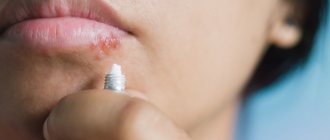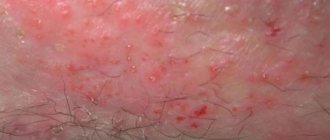The armpit, or axillary zone, acquired its own designation from the Old Slavonic “under the muscle”; anatomically it is cut off by the shoulder joint and also the chest. A large number of sweat and sebaceous glands together with hair follicles are concentrated in this area. The largest accumulations of lymphatic tissue are also present there - the lymphatic axillary areas.
This symptom can be caused by a heart attack, heart disease, or may simply be irritation on the skin. The first step is to inspect these surfaces; if a change in color or the appearance of a rash is noticed, this most likely indicates improper skin care. If, when you press on these depressions, you feel some kind of lump or compaction, this could be lymphadenitis, syphilis or tuberculosis.
If there is a burning sensation under the armpit, most often the cause of the malaise is clogging of the derivative ducts of the glands, inflammation of the hair follicles, lymph nodes, or disruption of the functioning of the chest organs.
Main Factors
Burning can occur due to a variety of factors, and the type of pain in accordance with this can also be quite different: sharp or dull, continuous or periodic, strong, pulling, cutting, formed at rest or with hand movements, accompanied by itching or redness of the skin.
All these properties help to suspect the root cause of the pathology and determine the diagnosis.
In some cases, the causes of burning under the armpit appear without pathology:
- Mastalgia - this pathology is characteristic only of girls of reproductive age. Pain appears due to hormonal changes in the body, they are considered secondary and arise due to compactions in the mammary glands. Unpleasant feelings, namely a burning sensation under the armpit in women, makes itself felt a couple of days before menstruation and disappears during or after the menstrual period. The intensity of pain can vary from mild discomfort to acute pain with every movement. It is quite difficult to cure such sensations, since their main factor is hormonal imbalance.
- The consequences of surgery - another cause of burning under the armpit, can be disturbing for another six months, depending on the severity of the surgery. Most of all, such pain occurs in girls who have had a mastectomy or resection. In this case, the nerve endings that innervate the axillary zone suffer, and their restoration takes from a couple of weeks to four months, during which time pain occurs.
Gynecomastia and steroids
Taking anabolic steroids often leads to the development of male gynecomastia. Steroid hormones contribute to the excessive formation of female sex hormones, in particular estradiol. As a result of long-term use of anabolic steroids by athletes, female-type adipose tissue deposition and bilateral enlargement of the mammary glands are observed. Athletes taking steroids should take care in advance to prevent gynecomastia. It involves taking special medications that block estrogen receptors. Ideally, an athlete’s career should be built without the use of steroid drugs, which have a detrimental effect not only on hormonal status, but also on the entire male body.
Localization of pain on the left side
If the burning sensation under the armpit of the left arm is not associated with diseases of the skin or subcutaneous fatty tissue, discomfort is also felt with disorders of the cardiovascular system. Most of all, such a burning sensation under the armpit on the left is considered reflected, and in addition to them, the patient is also worried about other signs that make it possible to recognize the pathology of the organs of the above-mentioned system. However, in some cases, weakness and aching pain become the main signs of myocardial infarction, a deadly disease.
Gynecomastia and liver diseases
Some liver pathologies can lead to the development of gynecomastia. Important metabolic processes occur in the liver tissues. This organ is responsible for the metabolism of steroids. Therefore, if its work is disrupted, with the development of hepatitis, alcoholic cirrhosis, the risk of mammary gland growth in men increases. Specific kidney enzymes lead to the destruction of prolactin and gonadotropins, as well as slowing down the release of body tissues from metabolic products. All this often leads to an increase in the level of prolactin and estrogen, causing the progression of gynecomastia.
Localization of pain on the right side
A burning sensation in the armpits on this side can occur for all valid reasons, in addition to myocardial infarction, with fairly rare exceptions. If there are no inflammatory changes and enlarged lymph nodes, pain appears due to osteochondrosis of the cervical spine or neuralgia. These diseases are characterized by a sudden increase in pain when moving, as well as a decrease in the range of movements - it becomes more and more difficult to move the arm, and the patient intuitively tries not to move it.
Injuries
It is enough to quickly raise your arm, bend over or lift a heavy object and thereby stretch the muscles or ligaments of the shoulder joint and chest. And an ordinary blow to the shoulder or an unsuccessful fall can provoke not only a soft tissue hematoma, but also a very significant sprain of muscles or ligaments. The pain and burning under the armpit in this case are not intense, nagging, continuous, aggravated by movement, especially when abducting the arm or trying to lift something difficult.
Lymphadenitis
Another one of the most well-known burning factors. Inflammation of the lymph nodes can be nonspecific: it is caused by all kinds of pathogenic microorganisms or a specific disease - tuberculosis, syphilis. As a rule, it burns due to acute inflammation in the lymph node area. The sick person's body temperature increases, trembling, weakness, headache and other signs of malaise intensify. Then there is swelling and severe discomfort in the armpit area, where you can simply feel the dense, unhealthy lymph nodes.
If you do not get rid of the disease, the inflammatory process can be localized, a compacted membrane of connective tissue will form around it, and the lymph node will begin to melt from the inside over time. A similar course of the disease is characteristic of specific tuberculosis or syphilitic inflammation. When infected with staphylococci, streptococci or other pathogenic bacteria, the infection often spreads throughout the body, initiating general intoxication of the body and damage to nearby lymph nodes and organs.
Examination for gynecomastia
To make a preliminary diagnosis, the doctor only needs to conduct a standard examination and palpation of the breast tissue and nearby lymph nodes. But an accurate diagnosis of gynecomastia is carried out only on the basis of the results of modern research. Ultrasound is considered the main diagnostic method. Specialists conduct ultrasound examinations of the mammary glands, scrotal organs, and axillary lymph nodes.
Laboratory tests are actively used, which include determining the level of testosterone, hCG, estradiol and prolactin, as well as other hormones (as indicated). If the development of a malignant tumor is suspected, a breast biopsy is prescribed. Additionally, magnetic resonance imaging and computed tomography of internal organs are used.
At the CONSTANTA Clinic, patients have access to many types of modern diagnostic and laboratory tests, which allow them to obtain the most reliable information about the patient’s condition and the functioning of all his internal organs, including the endocrine glands. We provide professional assistance to men with gynecomastia and provide both symptomatic and surgical treatment.
Gynecomastia is a serious disease that requires an integrated approach and the participation of experienced specialists. Delayed visit to the Clinic or the use of questionable home methods for treating gynecomastia in men can lead to the development of serious complications. Our specialists have modern therapeutic and surgical methods to combat this disease, which are highly effective and safe. You can discuss treatment options with your doctor. Do not hesitate to ask a specialist any questions that interest you. The doctors of the CONSTANTA Clinic are focused on respecting the interests of their patients and maximum concentration of professional forces on solving the problems of each patient.
Hidradenitis
This is an infectious disease, in most cases activated by staphylococcus. Inflammation develops due to skin defects, failure to comply with personal hygiene rules and a sudden decrease in immunity. Bacteria present on the skin of the face enter the sweat glands and stimulate their inflammation. The excretory ducts of the glands become clogged, their contents accumulate from the inside, and an inflammatory process forms under the skin. At the beginning of the disease, irritation and burning occurs in the axillary areas, then the skin turns purple, swelling occurs, the nodes increase, and become similar to a dog’s udder.
As the process progresses, the pathogenicity increases, the ulcers increase in size, become swollen and warm to the touch, and make it difficult to remove the arm or even move it at all. The patient’s general serious condition also worsens: body temperature increases, impotence, headache, vomiting and nausea occur. If therapy is not started in a timely manner, the abscess can open up on its own, creating a cavity full of pus, or the inflammation will spread to neighboring sweat and sebaceous glands, hair follicles and subcutaneous fatty tissue.
Gynecomastia and breast neoplasms
Tumors in the mammary glands are often mistaken for true gynecomastia. The process is most often one-sided, but sometimes the neoplasms involve two mammary glands at once. To the touch, the tumor has a dense consistency, is usually fused with adjacent tissues and has unclear contours. With breast tumors in men, bloody discharge from the nipples may appear, and sometimes the lymph nodes in the armpit become noticeably enlarged.
When a tumor is detected, specialists refer the patient for mammography, ultrasound, MRI and prescribe a biopsy, based on the results of which they can determine the nature of the tumor and make appropriate predictions for the future.
Folliculitis
Inflammation of the hair follicle can appear due to defects in the skin due to external influences: depilation, shaving, or a bruise or other injury to the axillary area. One or a couple of follicles can hurt, causing very significant redness of the skin, swelling, itching and burning under the armpits in men and women. A cavity filled with pus forms in the follicle, which can open on its own. One type of disease is staphylococcal sycosis, which often occurs in patients suffering from endocrine diseases, metabolic pathologies, or nervous system disorders. A distinctive feature of staphylococcal sycosis is a constant relapsing course and a large affected area.
Furuncle
Inflammation of the hair follicle, as well as the sebaceous gland and the connective tissue located around them. Factors in the formation of a boil are traumatic damage to the skin, frequent friction with clothing, violation of personal hygiene rules, decreased immunity and diseases of the endocrine system. When microorganisms enter the hair follicle, an inflammatory process is formed that spreads to the sebaceous glands and connective tissue. A follicle that has begun to progress implies a slight, painful thickening. When the process spreads, the patient shows signs of intoxication, namely an increase in body temperature, chills, severe weakness, headache, and so on, and a boil may appear at the site of the inflammatory infiltrate, or the inflammation will spread to the surrounding hair follicles, and the patient will develop furunculosis.
Gynecomastia and genetic pathologies
Genetic abnormalities often underlie the development of gynecomastia. Most often, excess growth of breast tissue is diagnosed in men with Klinefelter syndrome, in which an extra X chromosome is detected in the cells. These men have increased sensitivity to estrogen. With this disease, hyperprolactinemia occurs, which also increases the manifestations of gynecomastia.
In Klinefelter syndrome, puberty may occur on time, but puberty is often delayed. Patients exhibit predominantly tall stature and abnormal physique, in which the lower part of the body is significantly larger than the upper part. The size of the testicles is reduced. For chromosomal abnormalities, treatment of gynecomastia is predominantly surgical. The nodular form of the disease requires constant medical supervision and a biopsy after surgery or at the diagnostic stage.
Reifenstein syndrome occurs with increased estrogen synthesis and the development of gynecomastia. Symptoms of the disease usually appear during adolescence, when hormonal changes in the body occur. At the same time, experts identify signs of underdevelopment of the genital organs. Such patients require hormone replacement therapy with individual dosage selection.
True hermaphroditism also occurs with symptoms of gynecomastia. The patient usually learns about his problem at the beginning of puberty, when active growth of the mammary glands begins and other signs of the formation of a female-type figure appear.
What to do?
If a burning sensation occurs, then first it is necessary to establish the root cause of the pathology. A quick visit to a doctor can help not only eliminate complications, but also facilitate the healing process.
Before contacting a doctor, you must:
- carefully examine the axillary area - inflammatory changes, redness or swelling are easy to notice even with a simple examination;
- palpate the affected areas - in case of lymphadenitis, you will be able to find dense, painful large lymph nodes on one or even both sides;
- carefully adhere to hygiene - if irritation, redness or an abscess occurs on the skin, it is necessary to treat the armpits at least four times a day with warm water and soap and special products - a weak solution of potassium permanganate, hydrogen peroxide or other disinfectants;
- exclude factors acting on the nerves and traumatic factors - no matter what causes the pain, you must try to injure this area as little as possible, do not use roll-on antiperspirants, do not epilate or shave these areas.
In addition, you must beware of clothing that is tight to this area, hard materials that irritate the skin, and try to move your hand less.
Signs of inflammation of the skin of the armpit
- Itching
- Redness
- Peeling skin
- Appearance of rash (ulcers)
- Pain when scratching
Useful information on the topic of itchy skin:
- Dermatologist
- Itching due to skin diseases
- Itchy skin without manifestations on the skin
- Itchy skin in the groin
- Itchy skin on legs
- Itchy skin on hands
- Itchy skin on the back
- Itchy skin during pregnancy
- Itchy skin in liver diseases
- Itchy skin in children
- Itchy skin in the elderly
- Treatment of itchy skin
- Night skin itching
- Causes of itchy skin
Treatment
Unexplained discomfort in the form of a burning sensation can occur as a result of poor nutrition or too tight clothing. This symptom may appear after a muscle is stretched as a result of inflammation of the sweat glands or lymph nodes.
Treatment of burning under the armpit must be carried out strictly under medical supervision; for this it is important to consult a doctor. There may be a burning sensation in the area under the muscle; the cause of this discomfort is a chest injury.
When a burning sensation occurs, skin irritation is often visible. It is necessary to bathe these areas with laundry soap or manganese solution, treat with chlorhexidine after wiping the skin dry. Try to remove pressure clothing from this arm, wash the wound more often, avoid perfumes, cosmetics and hair removal. After you have tried the above methods and nothing has helped, you need to go to the doctor.
You can start with a therapist, if he doesn’t determine anything, then go to a surgeon. After making a diagnosis, a specialist may prescribe ointments or antiseptics. In severe cases, surgery is suggested. It is necessary to carry out a complete diagnosis of the body, donating feces, urine, and blood for testing. An x-ray will help you find out the cause of pain and burning in the area under your arm. If the x-ray does not reveal anything, there is an ultrasound and a computed tomograph.
Adviсe:
- Do not self-medicate under any circumstances, it is dangerous.
- If a new growth or compaction appears - hard or soft - under the skin, under no circumstances should such areas be heated. The pus will spread throughout the body, or the formation will increase in size.
- No ointments need to be used, as well as tight bandages and warming or cooling compresses.
- Under no circumstances should you start taking a course of antibiotics, as this will lead to a change in symptoms and the doctor will then be unable to make a correct diagnosis in a timely manner.
After you have visited the doctor, he will prescribe bandages and special ointments; you need to go to the hospital for bandaging. Antibiotics will be prescribed for oral administration. A UHF course will also be prescribed. The patient should go on a vitamin diet, which will consist of vegetables and fruits. Dishes such as pepper, fatty meats, alcohol and cigarettes should be removed from the diet.
If the treatment does not give the desired result, removal of the formation will be prescribed or all pus will be removed from it through an incision. When cleaning the pus does not give the desired results, the formation is removed along with the surrounding skin in order to destroy the infection.
Iatrogenic gynecomastia
Iatrogenic gynecomastia occurs when taking certain medications. The risk group includes patients who undergo hormonal treatment with estrogens, as well as other hormones (gonadotropins, glucorticoids). Against the background of hypogonadism, specialists often prescribe testosterone, which is toxic to the liver and can cause signs of temporary gynecomastia. Cardiac glycosides have a similar effect, stimulating the active production of steroids and disrupting the functional abilities of the testicles.
Drug-induced gynecomastia is most often a reversible process that can be stopped after stopping the medication that caused excessive breast growth. But it is necessary to stop taking medications as soon as possible. If you do not pay attention to the appearance of gynecomastia during drug therapy for 6-12 months or more, irreversible fibrotic processes will begin to occur in the breast tissue. The advanced form of the disease is subject to predominantly surgical treatment.
Treatment with folk remedies
Aloe is a fairly common and useful plant that heals any purulent and ordinary wounds. To cure, you need to take clean leaves of this plant and divide them in half with a knife. And this fleshy, sticky, juicy side should be applied to the sore spot. In addition to this plant, plantain juice and tea made from birch leaves and buds are also used to treat this disease. These techniques help at the onset of the disease, relieve inflammation, itching and burning.
Buy freshly picked celery leaves, wash them thoroughly and apply to the sore spot. Boil the onion in milk, make a paste with this liquid, mash the onion too and apply it in the form of compresses. Keep this paste on the wound for two to three hours. Buy fresh rye bread from the bakery, fry the pieces and apply this paste to the sore spot.
If all the advice given here does not help alleviate the symptoms of the disease, then the patient urgently needs to see a doctor so that he can determine the degree of risk and complexity of the tumor. After all, if purulent lumps are not removed in time, infection with pus can spread into the bloodstream - and the person dies. Timely and correct treatment will bring relief and health to all patients.
Preparation for surgical treatment of gynecomastia in men
No complex preparatory activities are carried out. The patient undergoes a comprehensive examination, which allows him to assess his health condition and choose the appropriate tactics for surgical intervention. Based on the diagnostic data, the doctor makes predictions for the future and selects the correct treatment regimen that prevents the development of complications, both during surgery and in the postoperative period.
The operation is performed on an empty stomach. The doctor will tell you in detail about the features of the surgical stage and recovery period. You must strictly follow your doctor’s prescriptions; if you have any questions or feel unwell, it is recommended that you contact your doctor without delay.











